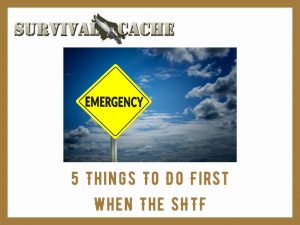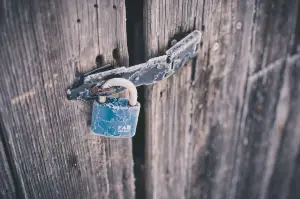There are so many different scenarios that come to mind when people mention SHTF. For some, it could mean almost any kind of emergency from a bad storm ripping through your town to a full-on apocalyptic event.

But for many, and the purpose of this article, I think people use SHTF to describe an event that is largescale, disrupts normalcy, and can last for weeks, months, or even longer.
Use whatever event you want to imagine that fits this description because for this article it isn’t so much the event that is important but what you do first when that emergency happens.
There are endless possibilities to think about when planning for these numerous scenarios and you need to realize what works best for you and your situation. As you read through the list below pleases feel free to move items around, add some, take away some. The five steps below are what I envision doing first in my situation for when the SHTF (WSHTF).
SKIP AHEAD
The 5 Steps at a Glance
- Get out of harm’s way
- Initiate communication plan
- Assess the situation
- Get to a safe zone
- Set up security
5 Things To Do First WSHTF
Out Of Harms Way
I know that this first step may seem obvious but it is worth discussing. When the SHTF I will get out of harm’s way, meaning that I will make sure I am not in immediate danger.
Now, almost everyone will do this instinctively but I feel that it is worth bringing up because there may be some that read articles like this and will start going through the steps without first getting out of harm’s way. Get yourself to a position where there is no immediate danger so that you can then decide what needs to happen next.
Initiate Communications Plan
When there is no longer an immediate threat to me I will initiate my communication plan. The communication plan is contacting anyone who is a part of your group. This could be friends, family, neighbors, or whoever you have made plans with for such events.
They need to be contacted, and everyone needs to be made aware of the situation and your emergency procedures should be enacted.
There is a very important aspect of this communication step that I have found many people do not consider. Let me put it to you this way, what would you and your group do if communications were down?
If you haven’t thought about this here is my recommendation. Within your group establish meeting locations and timeframes to wait at that location, in the event communications are down. Here is a quick example. An event happens, phones do not work, go to location “A.” Wait at location “A” for one day ( I am just using this timeframe for the example, set up your own timeframe) After one day go to location “B.”
By setting up a plan like this beforehand, group members will always know where they should go within a given timeframe to meet up with everyone else even when direct communications are down.
Assess The Situation

Once you are out of immediate danger, contacted the group, it is now time to assess the situation. This means on deciding on where to go next, how to get there, what do I have on me, what do I need, can I get there with what I have, will I have to spend the night where I am, and if so what how do I need to prepare for that?
There are going to be a lot of things to think about when the SHTF but do your best to prioritize those thoughts while keeping emotions in check.
Get To a Safe Zone
After assessing my situation it is time to take what I know and put it into action to get to a safe zone.
I decided on a safe zone rather than saying to get home or to a bug out location. A home is likely going to be everyone’s first choice when it comes to a place of safety but what if that location is no longer safe or you simply cannot get to it? Whatever your safe zone is, it would be a good idea to have several of them in mind and then put your plan in place to get to it.
Set Up Security

Once you have reached your safe zone, i.e. home, the next item that needs to be taken care of is setting up security.
You must have some means of protecting yourself. I am not going to tell you exactly what to have or how to go about this as that is a personal choice. But it is important to be able to protect yourself at all times.
Make sure all points of entry are locked down and secured. Here are a few quick suggestions for securing points of entry in a home.
- Insert a wooden dowel or piece of wood in the frame of windows that open vertically. This prevents the window from being opened even if it is unlocked. I like this better than completely boarding up windows or screwing them shut because the dowel is easily removed when an alternative exit is needed quickly, like in the case of a fire.
- Little push-button locks on door handles don’t do anything, nor do slide chains. Install deadbolts at a minimum.
- Replace the hardware on door strike plates. These strike plates are usually installed with very small screws, take them out and replace them with longer screws.
Now, security is not a “set it up and forget about it,” sort of a thing. It needs to be maintained 24/7. Again, here are just a few things to think about.
Window shades should remain closed and covered to prevent light from shining out. Reduce odors associated with cooking as smells can carry a long way. Do not talk about what the group has or your plans if there is a chance that others could overhear.
This last suggestion about not talking about the group’s supplies or abilities may seem simple, but remember that humans are social creatures by nature. It is very easy to get involved in a conversation with someone and to have certain information slip out. This applies not only during an emergency but before it as well!
Wrapping it Up
When the SHTF, situations can become confusing, crazy, and dangerous quickly. I hope that you use the above steps or at least use them to create your steps for having an initial plan in place because you do not want to be stuck in a bad situation wondering what you should do.
Thanks for reading and as always, stay prepared!

